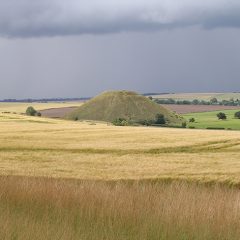For landscape work it may be useful to understand the following:
1. The most commonly met error in landscape work is an assumption that the blue grid squares on an OS map align to the cardinal points of the compass. They do not. Drawing up North-South or East-West lines on Ordnance Survey maps requires that you refer to the longitude printed around the top and bottom edges of the map, (for East-West lines the latitude on the right and left edges) from which North-South and East-West lines may then accurately be drawn onto the map.
Large scale maps emphasize this distortion to the level where most people think that Liverpool or Cardiff lie West of Edinburgh. They do not.
2. There is no substitute for visiting the site. Landscape work must eventually move from mapwork to the landscape itself. Why? Because modern OS maps take liberties with where they mark the location of sites. Secondly, when at the site, a GPS reading will
establish the latitude and longitude (and altitude above mean sea level) often to within 20 feet, which is much better than can be achieved easily from maps.
3. OS grid references refer to an area square and not to a single point. Therefore it is better to set up the GPS to read degrees, minutes and decimal fractions of a degree. Set the internal set-up of the GPS to OSGB, to correlate OS maps to the GPS’s readings. With the display reading DD MM.DDD resolution down to 15 feet accuracy of a location is obtained. DD.MM.SS only resolves to a second, which is about 100 feet.
Always record the elevation of a site. This often takes a few minutes to settle down on a GPS, but it makes issues with intervisibility between sites much easier to resolve if you recorded the elevation of each site and you are back at home 100 miles away!
.
4. If you use Google Earth, the indicated latitude and longitude will be slightly different from those on an OS map, and you will need to convert from WGS84 (Google’s) to OGB36 (OS). The website www.nearby.org.uk does this (and will also convert a grid reference to lat/long, with OSGB being displayed below the WGS84 reading). Google Earth is useful for indicating distances between sites although not always as accurately as do GPS readings taken on site.
5. Determining direction. The magnetic compass is best regarded only as a very rough guide to estimate direction in this type of work. The geology of Wales and Cornwall varies the compass reading, sometimes even reversing it! Much better is to use a GPS. To measure angles from a site, walk and peg a line of constant longitude (north-south) or latitude (east-west). Fix a cloth tape between the pegs, which realistically needs to be longer than a hundred feet. Use a large protractor to estimate other angles, for example to a prominent site on a distant horizon.
6. A theodolite is the ultimate tool for determining angles! Save the pennies and buy a secondhand one that does not invert the image.
